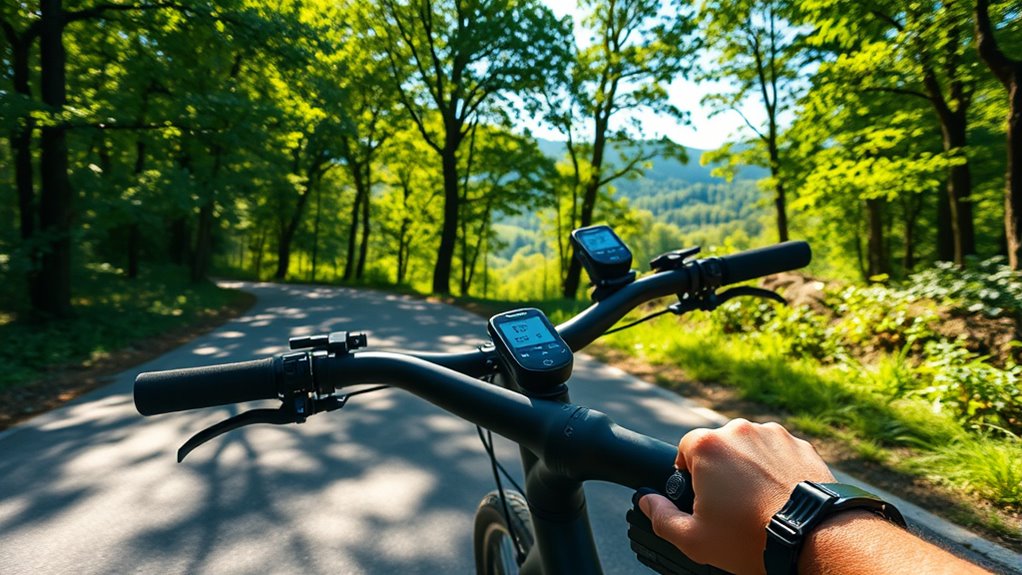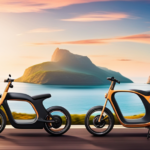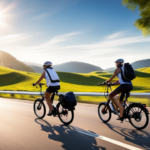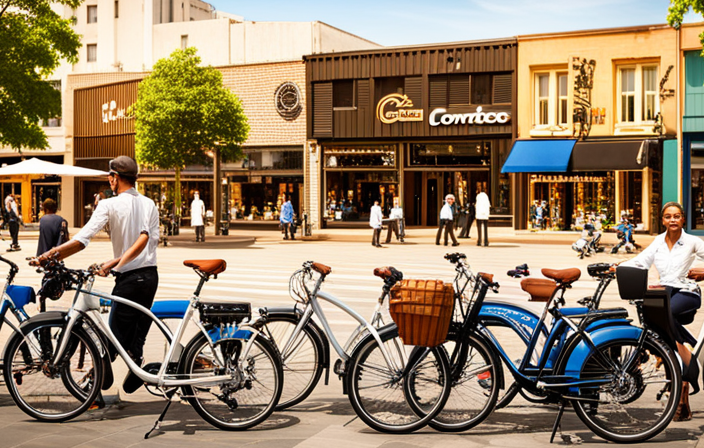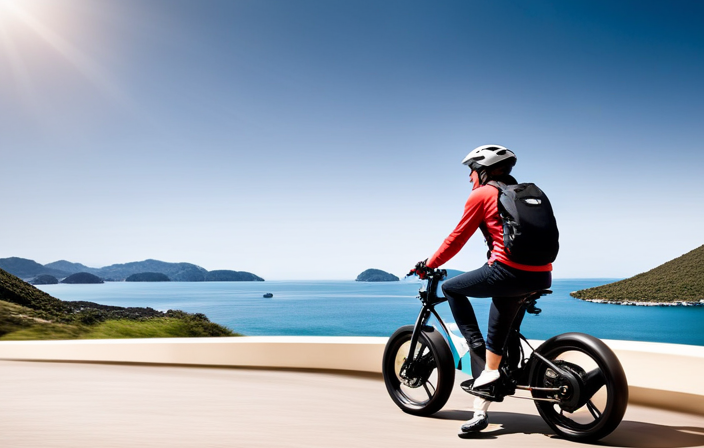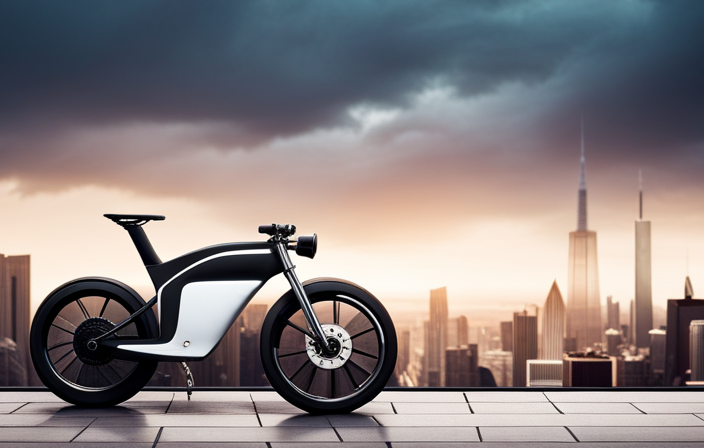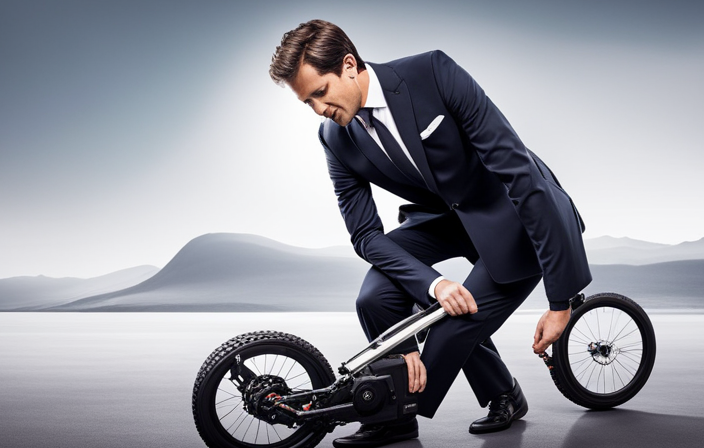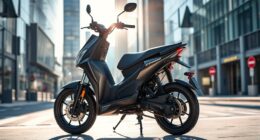Your e-bike’s range depends on many hidden factors, including riding style, terrain, and weather. Consistent, smooth pedaling and moderate speeds conserve battery life, while aggressive acceleration and heavy loads drain it faster. Uphill climbs and high winds require more energy, while proper tire pressure and battery care help extend your ride. Planning around terrain and avoiding full discharges can maximize distance. Stick with us to uncover even more tips for getting the most out of your e-bike.
Key Takeaways
- Riding style, including steady pedaling and smooth acceleration, significantly impacts battery efficiency and overall range.
- Terrain and elevation changes, especially uphill climbs, increase energy consumption and reduce riding distance.
- Weather conditions like cold, wind, and rain affect battery capacity and riding efficiency.
- Proper tire maintenance and minimizing extra load help lower rolling resistance and extend range.
- Battery care—avoiding full discharges, proper storage, and monitoring—maintains capacity and prolongs performance.
Rider Behavior and Pedal Assist Settings

Your rider behavior and pedal assist settings directly impact your e-bike’s range. Maintaining a steady pedal cadence helps conserve battery life since consistent pedaling reduces sudden power surges. If you pedal too fast or too slow, your assist level adjusts constantly, which can drain the battery faster. Choosing a lower assist level, like eco or minimal, extends your ride by reducing the motor’s workload, while higher levels offer more assistance but shorten your range. Being mindful of your pedal cadence and adjusting assist levels based on terrain and effort can substantially improve battery efficiency. Smooth, steady pedaling combined with appropriate assist settings ensures you maximize your e-bike’s range without sacrificing comfort or performance. Additionally, understanding how high refresh rates influence your riding experience can help you optimize settings for smoother, more responsive rides.
Terrain and Elevation Changes

When you ride uphill, you’ll notice your e-bike’s battery drains faster due to increased resistance. Conversely, going downhill lets you recover some range as gravity assists your movement with less effort. Understanding how elevation changes affect your ride helps you plan better and extend your e-bike’s overall range. Additionally, proper maintenance and tire pressure can optimize efficiency and battery life during varied terrain.
Uphill Resistance Impact
How much does uphill resistance affect your e-bike’s range? When climbing steep inclines, your motorized assistance works harder to overcome increased resistance. This extra effort drains the battery faster, reducing your overall range. Uphill gear ratios come into play here; shifting into lower gears helps you pedal more efficiently, allowing the motor to assist ideally without overexerting itself. Using the right gear ratios can make a significant difference, conserving battery life on challenging climbs. Keep in mind that higher assistance levels also increase energy consumption, so dialing back assistance when possible can extend your ride. Additionally, portable camping gear like lightweight tents and power banks can help you manage your equipment more efficiently during extended rides. Ultimately, tackling uphill sections demands more from your e-bike’s motor, which shortens your range compared to flat terrain. Planning your route with this in mind helps you avoid unexpected battery depletion.
Downhill Recovery Benefits
Descending terrain offers valuable opportunities to recover battery energy, as gravity assists your e-bike’s movement and reduces the motor’s workload. When you ride downhill, gravity assistance naturally boosts your speed without extra effort from the motor, leading to significant energy savings. This speed recovery allows your battery to replenish some charge, especially if your e-bike’s system supports regenerative braking. By maintaining a steady, controlled descent, you optimize this benefit, extending your riding range. Keep in mind that the steeper and longer the downhill, the more effective the energy recovery. Properly leveraging terrain changes can make a noticeable difference in your overall battery life, giving you more confidence to explore longer routes without worry. Downhill recovery is a smart way to conserve power and maximize your riding experience. Additionally, understanding how cookie categories are used can help you manage your online privacy while researching terrain options.
Weather Conditions and Temperature Effects
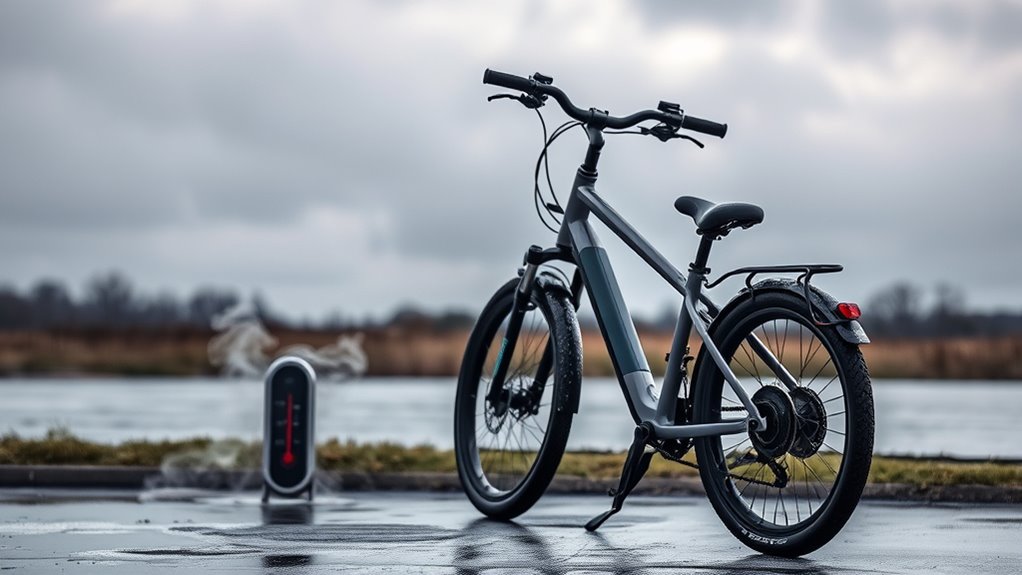
Weather conditions and temperature have a significant impact on an e-bike’s range, often making the difference between a smooth ride and unexpected limitations. Climate variability and seasonal shifts influence battery efficiency, reducing range in cold or hot weather. Cold temperatures slow chemical reactions inside the battery, decreasing capacity, while heat can cause overheating and degrade battery life over time. Wind resistance also plays a role, especially during gusty days. To visualize, consider this table:
| Weather Condition | Effect on Range | Tip |
|---|---|---|
| Cold temperatures | Reduced battery capacity | Keep batteries warm |
| Hot weather | Accelerated battery degradation | Avoid prolonged sun exposure |
| Windy days | Increased resistance, lower range | Ride with the wind when possible |
| Rainy or humid conditions | Reduced grip, potential electrical issues | Use waterproof gear |
Tire Pressure and Wheel Maintenance
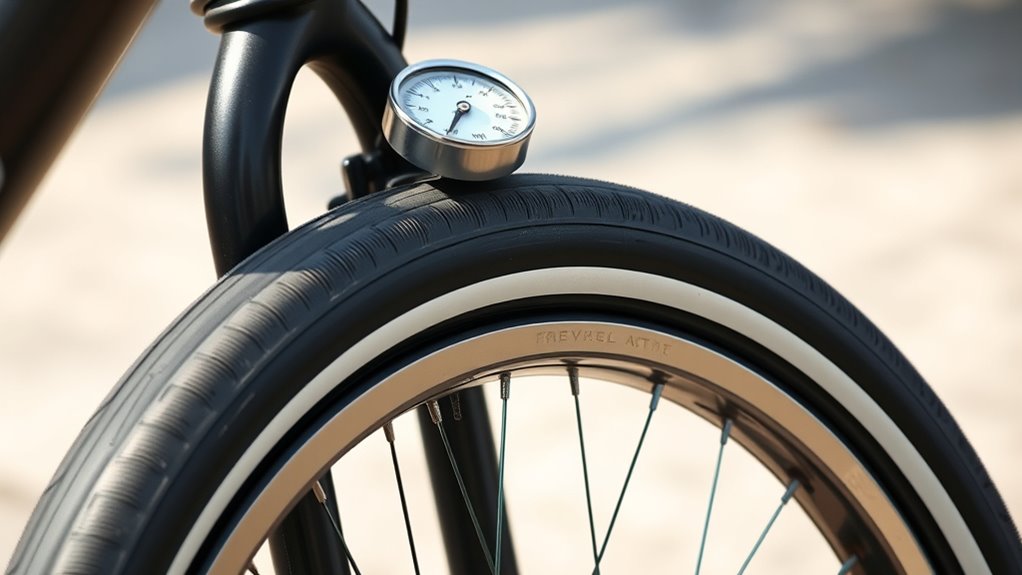
Maintaining proper tire pressure and wheel condition is essential for maximizing your e-bike’s range and ensuring a smooth ride. Tire pressure optimization reduces rolling resistance, helping you go farther on each charge. Check your tires regularly and inflate them to the recommended pressure for your specific bike and riding conditions. Under-inflated tires increase drag and wear out faster, while over-inflated tires can compromise comfort and control. Additionally, perform wheel alignment checks to prevent uneven tire wear and ensure your wheels spin true. Misaligned wheels create additional resistance, draining your battery more quickly. Regularly inspecting and maintaining your tires and wheels not only prolongs their lifespan but also enhances efficiency, allowing you to enjoy longer rides with less effort. Proper tire pressure and wheel care are also crucial for avoiding potential side effects such as uneven wear and reduced performance.
Battery Age, Capacity, and Care

Your e-bike’s battery is a critical factor in determining its range, and understanding how age, capacity, and care affect performance can help you get the most out of each charge. Over time, battery degradation reduces capacity, meaning you’ll get fewer miles per charge. Proper charging habits are essential—avoid letting the battery completely drain or stay fully charged for extended periods. Instead, aim to keep the battery between 20% and 80%, and charge it regularly. Also, store your e-bike in a cool, dry place to prevent unnecessary wear. As your battery ages, its capacity diminishes, but good care can slow this process. Understanding the importance of battery maintenance and how it impacts longevity can further enhance your e-bike experience. By paying attention to these factors, you’ll maximize your battery’s lifespan and maintain ideal range.
Riding Speed and Acceleration Patterns
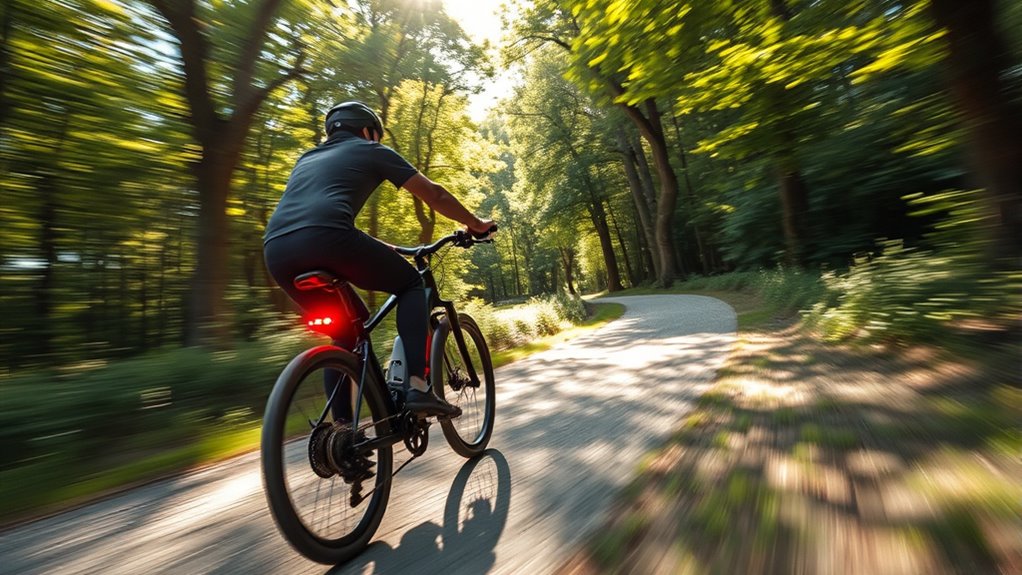
Riding speed and acceleration patterns have a direct impact on your e-bike’s range, as higher speeds and abrupt accelerations drain the battery more quickly. When you ride faster, aerodynamic drag increases exponentially, forcing the motor to work harder and reducing efficiency. Rapid acceleration also demands more power, causing the motor to draw more energy in a shorter time. Maintaining a steady, moderate pace helps optimize motor efficiency and minimizes energy loss due to drag. Smooth acceleration and deceleration keep the motor running efficiently, conserving battery life. If you want to extend your ride, avoid pushing to top speeds unnecessarily and practice gradual acceleration. Your riding style directly influences how efficiently your e-bike uses its battery, affecting overall range. Additionally, choosing appropriate riding techniques that promote steady speeds can significantly improve your e-bike’s energy conservation.
Load, Cargo, and Accessories Impact
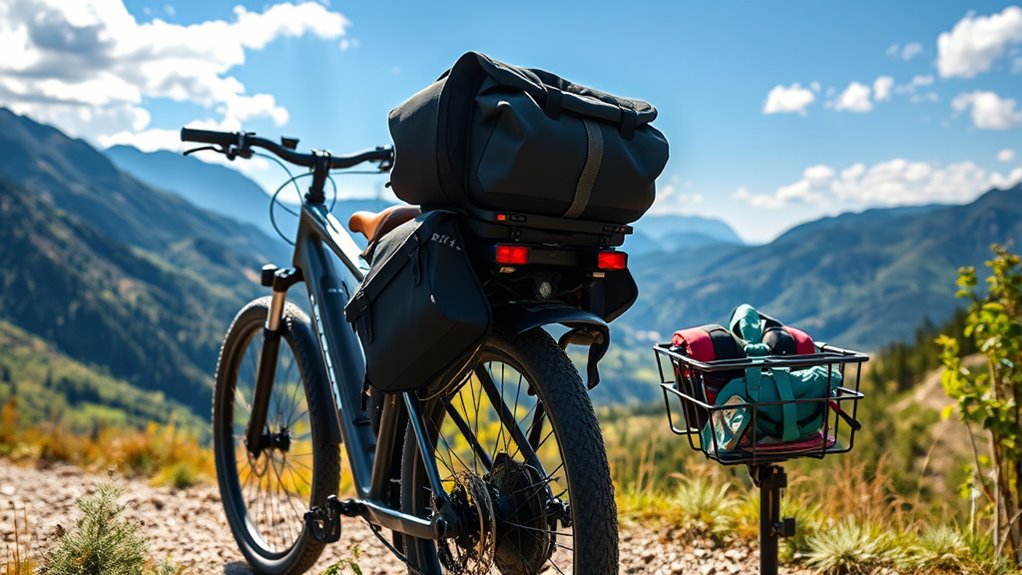
Carrying extra load, cargo, or accessories on your e-bike increases the overall weight the motor must handle, which in turn reduces your bike’s range. Heavier loads demand more power, especially when climbing hills or accelerating, causing your battery to drain faster. Modern battery technology helps mitigate some of this impact by providing higher energy density, but weight still matters. Additionally, if you frequently ride with accessories like racks or panniers, plan your trips around nearby charging stations to avoid running out of power. Keep in mind that added weight not only affects range but also influences handling and braking. To maximize your e-bike’s efficiency, minimize unnecessary cargo, and use energy-efficient riding habits, especially when battery technology or charging station access is limited.
Frequently Asked Questions
How Does Riding Style Influence E-Bike Range Over Time?
Your riding style directly affects your e-bike range over time. If you maintain a good riding posture, you’ll reduce unnecessary energy expenditure, extending battery life. Choosing smoother terrain, like paved roads, also conserves power compared to hilly or rough paths. Aggressive riding, like rapid acceleration or high speeds, drains the battery faster. So, by riding more efficiently and selecting your terrain wisely, you can maximize your e-bike’s range and longevity.
Can Customizing Pedal Assist Levels Significantly Extend Battery Life?
Yes, customizing pedal assist levels can greatly extend your battery life. By adjusting assist settings, you optimize power management, reducing unnecessary energy consumption. Regular battery calibration ensures accurate readings, helping you select the most efficient assist levels. This combination allows you to conserve battery, ride longer distances, and maximize your e-bike’s performance without sacrificing support or comfort.
What Hidden Factors Cause Unexpected Battery Drain During Rides?
Like a hidden leak, unexpected battery drain sneaks up on you. You might not realize that poor charger quality or outdated battery calibration causes this. If your charger isn’t reliable or your battery isn’t properly calibrated, it’ll work harder, wasting energy. Always use high-quality chargers and regularly calibrate your battery to keep the power steady. This way, your ride stays smooth, and you avoid surprises mid-journey.
How Do Different Tire Brands and Models Affect Overall Range?
Different tire brands and models can considerably impact your e-bike’s range by affecting rolling resistance. Low tire pressure increases resistance, while tread patterns influence efficiency on various surfaces. Choose tires with smoother tread for better range on paved roads, and maintain proper tire pressure to reduce energy drain. By selecting the right tires and keeping them properly inflated, you’ll maximize your bike’s efficiency and extend your riding distance.
Does Riding With or Against the Wind Drastically Change Range?
Riding against the wind can cut your e-bike’s range in half or more—it’s like pedaling through a wall of molasses. Wind resistance drastically impacts aerodynamics, forcing your motor to work overtime. When you ride with the wind, you’ll glide effortlessly, stretching your battery life. So, yes, fighting or riding with the wind can make a huge difference—prepare for a significant range change based on wind conditions!
Conclusion
Understanding these factors helps you get the most out of your e-bike. By adjusting your riding habits, maintaining your bike, and caring for the battery, you can extend your range and enjoy smoother rides. Remember, a chain is only as strong as its weakest link—pay attention to each aspect. Stay mindful of these tips, and you’ll ride further with less worry. Keep these insights in mind and make every trip count.
